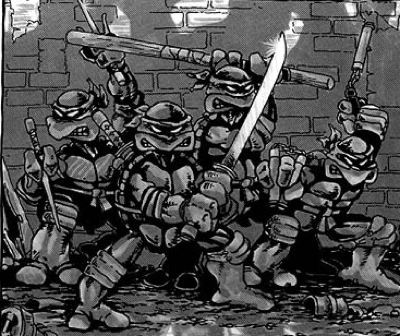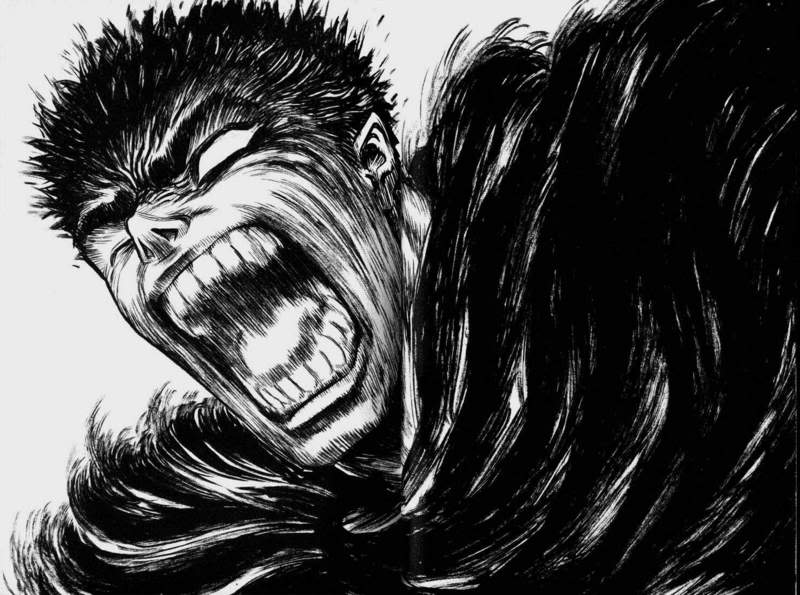Considering Comics: Black and White VS. Color
Comics have always been first and foremost a visual medium. There are countless artists that have been, will be, and are involved in comics, each with their own style. Now, one style may certainly appeal to guy A more than it does to girl B, but there is one factor in comic art that seems to make a big difference: Is it in color?
Originally, just like film, television, and photography, comics were primarily in black and white. The very first of what we presently call comics were found in the pages of magazines and newspapers. Many of these early comics were used for political and social commentary, such as Richard Outcault’s “The Yellow Kid." Soon to follow were the multi-panel comic strips. Since newspapers were printed entirely in black ink on white pages, so too were the comic strips. This practice, as far as I have been able to find, has always been due to ease of manufacturing.

Newspapers are printed daily and in massive quantities. Printing only in black ink simply makes mass distribution faster and cheaper. When some of these comic strips were reprinted in book format, we got our first comic book.
Of course, times change and it was not long before comics were being printed in color ink. Newspapers have traditionally continued to run black and white strips daily, while leaving the Sunday paper for comics to use color; often presented more elaborately than the simple strips of a few panels. As we are well aware though, comics did not stay relegated to the pages of newspapers. The 1930s saw the first original American comic books on the market. These early comic books featured fully colored pages and this has been the tradition in professional American comics ever since.
When I say “professional American comics,” it is probably no big secret that I am referring to Marvel, DC, those of their ilk, and those who aspire to be them. However, there are many producers of comic books in the world and not all of them adhere to the same choices. Specifically, when I think about modern black and white comic books, I think of indie comics and Japanese manga.
For the most part, you will generally find these two types of comics inked in black and on white pages. Independently produced comics like “Scott Pilgrim” and “Tank Girl” are printed entirely in black and white, save for an occasional few color pages. These are popular in the U.S. but actually come from Canada and Britain, respectively. If you want to look at an American example of black and white indie books though, there are some like “Johnny the Homicidal Maniac” and the original “Teenage Mutant Ninja Turtles.”
Similarly, virtually all Japanese manga are produced in black and white. Occasionally you will find a few color pages to start the chapter of some of the more successful series, but these are generally presented as a rare treat. The difference here is that these are not indie comics by any means. Even when a series gains enough acclaim that is reproduced as an animated television show, fully displaying all the same scenes in color, Japanese comics continue the longstanding tradition of being illustrated in black and white.
The reasoning for this is, of course, utterly unremarkable. It’s already been mentioned that newspapers in the past found printing in black and white to be cheaper, easier, and faster and that truth has not changed. Indie comics generally do not have the funding nor resources of professional comics and they have to work a lot harder to make a profit. Printing in black and white fulfills some very basic needs here; specifically, the three I just mentioned. Likewise, popular manga series do not release on a monthly basis, like American comics do. In Japan, there is a new chapter for many of these comics every week. Coloring these issues on a weekly basis would simply take too much time, in many of these cases. A simple answer to a simple question.
OR IS IT?
Now that we have more context than anyone ever wanted, I really want to know: Why are some comics in black and white and some in color? Obviously, there are some very practical reasons for it. All those reasons I just explained, for instance. Even so, I have a hard time believing that this is all there is to it. To a certain degree, it just does not add up.
Let’s look at manga again. Sure, a great many of these series are produced very quickly and they need to meet those quick deadlines to stay competitive. However, not all series run on a weekly basis. Is there a legitimate production reason why these comics are still only printed in black and white that I have simply missed because I did not do enough research? Very possibly. At the same time, though, I do not think it can be ignored there is very much a sense of tradition surrounding black and white Japanese comics. As I said earlier, when I think of black and white comics, one of the things I think of is manga. Not specific titles, like with the indie comics, but the medium of manga as a whole. It is expected that manga is going to be in black and white. Despite this, manga is very popular in Japan. No one seems to balk at reading

comics in black and white nor is there a pervading sense that manga artists are just being lazy by not coloring in their work. Could this simply be what Japan is used to or could it be a cultural matter? Is it neither?
Similarly, do indie comics ignore coloring due only to lack of resources? Sure, there is often an entire new position to be filled on a comic for colorist, but one wonders how much of an obstacle that really becomes to some independents. Surely, if coloring a comic was all it took to become a breakout success, then everyone would be doing it. Even with some of the more popular series though, we see this trend persist. Just as there seems to be a sense of tradition surrounding black and white manga, I think the same can be said of indie comics. When I open a book full of black and white art, personally, I feel like I am being told “this is a comic for adults.” In my mind, there is a definite sense of “We don’t need colorful art here. Bright colors are needed to appeal to kids, but we’re big boys and girls. We can appreciate art without lame crap like reds and blues.” To me, this is a vibe very much in sync with the indie comic world. If any of these claims attain any degree of accuracy, then it begs the question: Is this really a deliberate choice and why?
Earlier, I mentioned that comics are one of many visual medias that began in black and white before moving to color. Among those media are photography and film. In both of these cases, there are examples of art and entertainment. Furthermore, in both of these cases, particularly in what most consider “art,” there are examples of black and white. Despite most films and photography currently taking advantage of color technology, there is a certain timeless draw to going back to black and white. Not every production benefits from it, of course, but it can lend a certain element of class to certain works. In these fields there is no question of using black and white to save on cost or manpower, but it is still used. Therefore, at least in film and photography, color is not objectively better than black and white. I would like to think the same is true of comics.
So, is there an aesthetic debate to be had here? Personally, I do not see one style as better or worse than the other; just different. Could comics be produced more quickly and, as a result, achieve greater success if more of them were printed in black and white? Perhaps there is a perceived loss from finding a comic without color that keeps black and white books from achieving a greater audience. Consider it and, if you have an opinion, let me know in the forums.
 Newspapers are printed daily and in massive quantities. Printing only in black ink simply makes mass distribution faster and cheaper. When some of these comic strips were reprinted in book format, we got our first comic book.
Newspapers are printed daily and in massive quantities. Printing only in black ink simply makes mass distribution faster and cheaper. When some of these comic strips were reprinted in book format, we got our first comic book. comics in black and white nor is there a pervading sense that manga artists are just being lazy by not coloring in their work. Could this simply be what Japan is used to or could it be a cultural matter? Is it neither?
comics in black and white nor is there a pervading sense that manga artists are just being lazy by not coloring in their work. Could this simply be what Japan is used to or could it be a cultural matter? Is it neither?